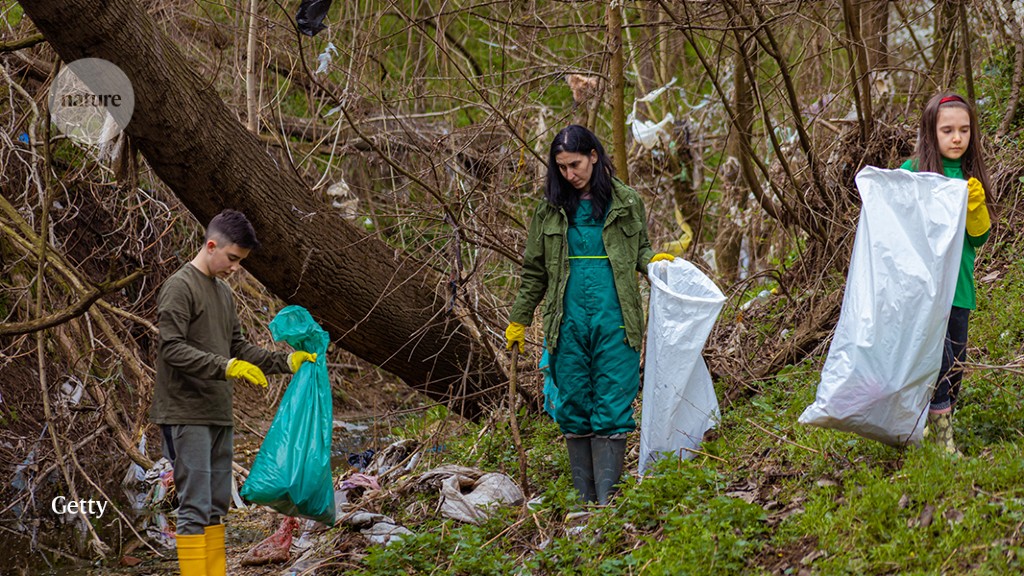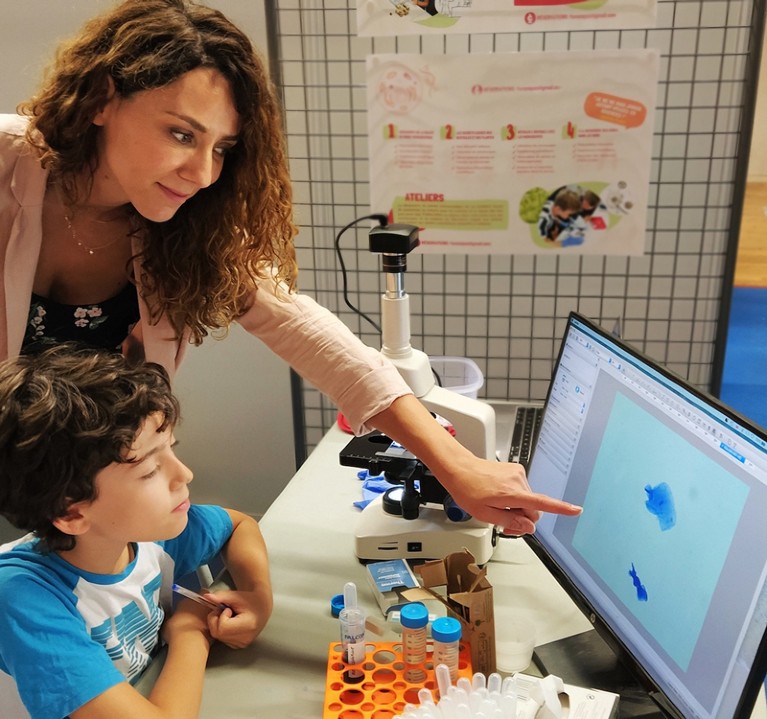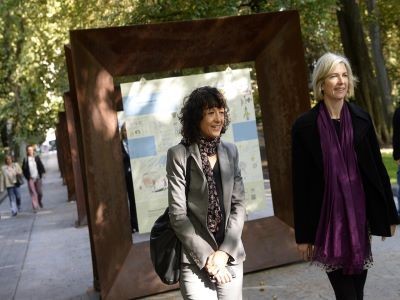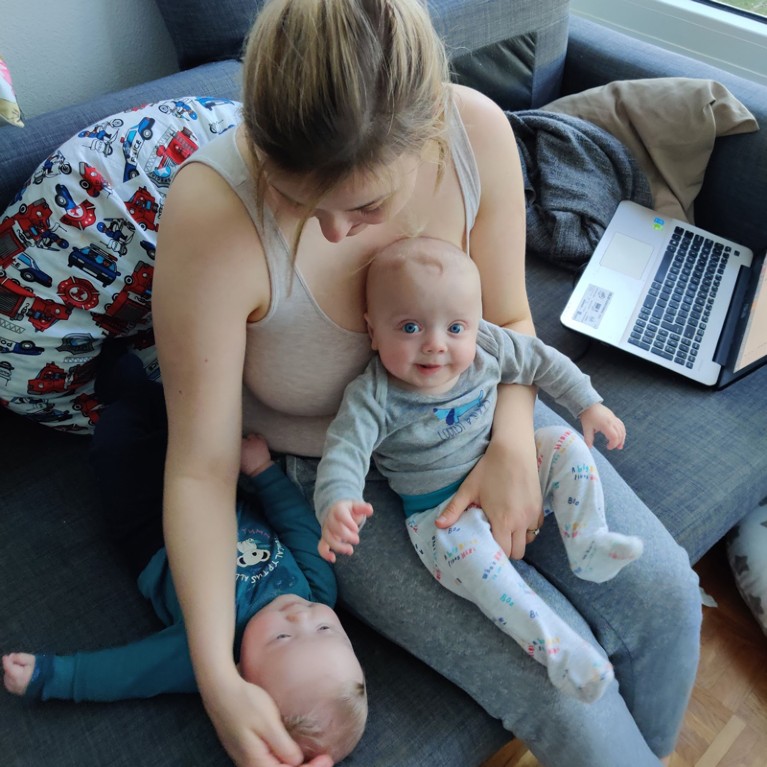Discrimination against women in academia drives mothers out of research careers, a new report says.Credit: Getty
Funding agencies worldwide must abolish the systemic barriers that have historically prevented female academics, including researcher-mums, from moving forward professionally, says a coalition of organizations around the globe that collectively represent millions of women in science, technology, engineering, mathematics and medicine (STEMM).
The coalition, led by Mothers in Science (MIS) — an international non-profit organization based in France — released a report this month that outlines policies for funders that, it says, will banish the long-standing discrimination against scientist-mums and overall gender bias in the scientific enterprise.
Collection: Diversity and scientific careers
Such discrimination, the report says, drives mothers out of research careers and stymies all female scientists’ career advancement. Grant agencies must adopt schemes that block built-in bias, such as providing funds for women on parental leave to replace themselves in the lab, and modifying grant applications to allow an accounting for lost productivity during that leave, the report says. Because success in academic research is based on bringing in money, coalition members say that the global funding system has an obligation to acknowledge the hardships researcher-parents face and to ensure that agencies are awarding grants and fellowships fairly.
The call to action follows a global survey, conducted by MIS and five partners in 2020, that tried to quantify the ‘maternal wall’ — a series of obstacles in academia that limits scientist-mums’ career progression. That survey found that in the years after starting their families, mothers often encountered bias and discrimination, prompting many to leave their full-time jobs.
“When we are talking about motherhood [and science], people see it as a private issue and tend to treat it as an individual problem, says Isabel Torres, a mother of four and the co-founder and chief executive of MIS. “We’ve shown that it’s a structural problem. What we want now is for [funding agencies] to acknowledge the data and take accountability. Funding is fundamental for career progression in academia.”
Isabel Torres with her son. She co-founded Mothers in Science, an international non-profit organization that advocates for women in scientific, technical and medical fields.Credit: Isabel Torres
Besides MIS, the 17 endorsing organizations behind the report include the Association for Women in Science and 500 Women Scientists, both US non-profit organizations, and the European Platform of Women Scientists, a non-profit organization in Brussels.
A number of funders, which collectively control the annual distribution of billions of research dollars, say that they are interested in working with the organizations to roll the recommendations into their existing policies. Those funders include Australia’s National Health and Medical Research Council (NHMRC), the European Research Council (ERC), the US National Institutes of Health (NIH) and the Natural Sciences and Engineering Research Council of Canada (NSERC).
Putting numbers to the problem
Before the 2020 MIS-led survey, which examined the full extent of parental discrimination in STEMM, the challenges faced by scientist-mums existed largely as an underlying murmur of anecdotal stories.
Fernanda Staniscuaski, for example, began her career in 2011 as a molecular biologist at the Federal University of Rio Grande do Sul in Brazil, calling her research a “full-time devotion”. But after she became a mother, Staniscuaski says, she immediately ran up against structural obstacles. The time available for her to submit grants and write papers decreased sharply in the year and a half after she first became a mother. And her lower productivity continued after she had two more sons, but there often wasn’t a way to explain that on her grant applications.
Molecular biologist Fernanda Staniscuaski in the laboratory with two of her children. She advocates for gender-balanced policies in Brazil.Credit: Flávio Dutra
As a consequence, she received more grant rejections and fewer professional opportunities, such as invitations to collaborate or to travel for conferences, than she had before becoming a parent — a snowball of obstacles that limited her ability to advance. “When I was compared to my peers, I was behind,” Staniscuaski says. “I thought that was really unfair. I didn’t become incompetent or lose my passion for science, I just had a break because I was raising my children.” Ultimately, she began advocating for gender-balanced policies in Brazil full time, setting her research aside and launching the non-profit organization Parent in Science in 2016.
In 2021, MIS held a conference to bring together groups studying gender discrimination in STEMM and to share the preliminary results of their global survey (the full report is expected to be published this year), which reached roughly 9,000 researcher-respondents in 128 countries, including parents and those without children.
Key takeaways from the survey, corroborated by earlier, country-specific studies1, include the fact that in the decade following the birth or adoption of their first child, scientist-mums published at least ten fewer papers on average than did scientist-fathers. Women were also three times more likely than men to say that they received fewer offers of professional opportunities after becoming parents, and roughly one-third of mothers in full-time STEMM positions ultimately left their jobs. This maternal wall represents one of the most common forms of gender discrimination in academia, Torres says, and yet little has been done to stem the attrition.
It is important to focus policy change on the funding system, say members of the MIS report’s endorsing groups. Katie Wagner, an evolutionary biologist at the University of Wyoming in Laramie and a member of 500 Women Scientists, says that scientists advance in their careers in part by bringing in prestigious grants and publishing in high-impact journals, and that parents who take time away with their families often miss out on these opportunities and struggle to make up lost ground. “As scientists, we have to demonstrate that we can obtain funding at every point in our career to continue to progress,” Wagner says. “Funding agencies are contributing to gender inequity, and, therefore, can be a huge player in equalizing those inequities.”
Scientific collaborations are precarious territory for women
The report highlights six focus areas. These include the need for financial support to ensure research continuity; flexibility for parents and caregivers, including remote working options; systems for tracking diversity and inclusion and for flagging suspected discrimination; a simplification of the application and evaluation process for grants and fellowships; and addressing the disproportionate impact that the SARS-CoV-2 pandemic has had on female scientists. The immediate goal, Torres says, is to bring these concerns to the biggest funders with the largest reach, including the NIH, the world’s largest public funder of biomedical research. “We hope that once we have one or two of the big ones who have made some changes, the others will follow,” she says.
The report also includes examples of good practices already in effect and that create a sliding scale of strategies for organizations to consider. Among the easiest to implement, according to Torres, are things such as rolling deadlines, and extensions and deferments for grants; application formats that allow scientists to explain lapses in productivity; and unconscious-bias training for grant reviewers coupled with an appeals process for when bias is suspected.
At the other end of the spectrum, the NHMRC, which funds Australia’s health and medical research, has implemented gender quotas and will award half of its mid- and late-career research grants in 2023 to women and non-binary scientists. Anne Kelso, the agency’s chief executive, says that the NHMRC adopted these changes after reviewing 20 years of data on the demographics of grant applicants and awardees. Kelso and her team realized that although more women were entering STEMM fields during that period, they were not receiving promotions. “We came to the position [that] it is time to take this very substantial step,” she says.
Answering the call
A spokesperson from the NIH’s Office of Extramural Research says that the agency often creates working groups of external scientists to tackle emerging issues — including topics related to diversity and sexual harassment — and that such discussions have helped to shape policies around funding scientist-parents. “It is through these and other work–life integration policies,” the spokesperson said in an e-mail, “that we can better ensure a competitive and diverse workforce for the biomedical research enterprise now and in the future.”
Other agencies, including the ERC and the NSERC, have dedicated committees that advise their leadership on issues of diversity, equity and inclusion. Kristina Archibald, director of the research grants and scholarships portfolio at NSERC, says that she will work with the committee to assess whether any of the report’s suggestions could enhance the agency’s existing practices. She notes that NSERC does not currently parse its diversity data by parental status, for example, but that doing so could help to determine whether its policies adequately support mothers.
Kamila Delaney, a postdoc in Geneviève Almouzni’s laboratory at the Curie Institute in Paris, working from home with her children.Credit: Brendan Delaney
Geneviève Almouzni, a molecular biologist at the Curie Institute in Paris and a member of the ERC, which awards prestigious grants to scientists worldwide, says that the agency created a gender equality plan in 2008 that is regularly evaluated and updated. The measures outlined in the MIS report, she adds, could, therefore, help to shape the next iteration. As a young scientist, Almouzni recalls feeling that parenthood was difficult to reconcile with a research career. She has worked throughout her tenure at the ERC to develop policies — such as extending the eligibility window for scientist-mums to apply for certain early-career grants to accommodate parental leave — aimed at easing the transition into parenthood and retaining researchers in the sciences who bring a variety of perspectives and life experiences. The funding system must not lose sight of the importance of cultivating and supporting a diverse research community, she says.
Ultimately, Staniscuaski says, grant agencies must recognize and acknowledge their role in making that diversity possible. “Any institutions that are funding research or science should be interested in excellence, and we know that diversity — which includes women and mothers — is central for excellence in science,” Staniscuaski says. “They should really be focussing on diversity if they want progress. There’s no way around it.”











More News
Daily briefing: Why exercise is good for us
Daily briefing: Orangutan is first wild animal seen using medicinal plant
Old electric-vehicle batteries can find new purpose — on the grid